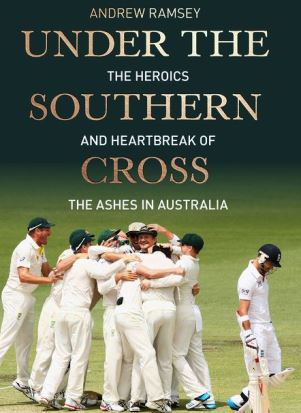Under the Southern Cross
0Andrew Ramsay is the type of articulate Australian cricket journalist that is not from the club of recent Channel 9 days. Here he has written the history of Ashes cricket in Australia.
He is not Australia’s Neville Cardus; that’s Gideon Haigh, but he’s the next best thing. He has written for most Australian and UK broadsheets in his time, and has covered over 100 Ashes tests. And he writes with that combination of the love of the game while still pointing out the rubbish bits.
This is a book that is a pleasant yet pretty intensive assault on the senses. Ramsay’s writing is cultured and varied, without ever descending into clichés.
The presentation is rich. A range of font colours and backdrops is used, without turning into a bad-look website, and the illustrations are a feature.
And then there is the aroma. It smells like a proper book. It’s not quite the size of a clichéd coffee table book, but that’s where it belongs.
The book starts with a breeze through the five Ashes venues; those grounds we have got to know so well here.
There is the vastness of the MCG, and its micro-climate, the eccentricities and the proximity of the crowd at the SCG, fortress Gabba and its history, and the contrasting sun-baked desert pitches in Adelaide and Perth. It’s all about the turf.
Perth is a world famous test venue, but it only came about in 1970 as a result of jet air travel.
As a sample of the writing style.
The extremes of Australia’s summer are even more alien to visitors from England. Whether it’s the sub-tropical steaminess of Brisbane, where spirit-sapping mornings have suddenly given way to afternoon hailstorms, or Adelaide’s oven-like desert dryness, Test match days in Australia radiate a heat and a ferocity not known on the famously damp, dank North Atlantic island.
This gives you an insight into the quality of writing, along with the focus of this book being about the Ashes in Australia. The Crown v Colony narrative is entrenched in Ashes cricket like no other contest. “They played people in Australia not necessarily there by choice”.
It is split into sections. After the grounds there are sections on Australian players who have had an impact, likewise the tourists, famous controversies; the summary of Bodyline evokes the antagonism well, the John Snow series, and famous tests such as Adelaide 2006.
For example the chapter on Reginald Foster, still the owner of the highest test score on test debut, is an insight into another world. He was one of seven sons born to a Malvern clergyman. He played football for England five times, once as captain, yet the stockbroker walked out onto the SCG as a derided toff.
For seven hours batting he toyed with them.
And then there is the Colin Cowdrey chapter. A veteran of six Ashes series, his most famous was his last one in 1975, aged 41 when he got a pleasant greeting from Thommo; all in the name of bolstering a shell-shocked side.
Has there ever been braveness like a retired 41 year old Cowdrey putting away the embroidered slippers of a well earned retirement in an English winter to face Lillie & Thommo in the furnace at the fastest pitch of its time? He even opened in one test when Luckhurst was injured. Following the last test of that series he was the last player to leave the field; signing autographs in his straw hat.
If anyone deserves Ashes reverence it’s MCC.
The chapter on Frank Tyson is also an interesting one. The English Literature graduate from Durham University could freely quote the romantic poets, and his preferred on-tour reading material ranged from Chaucer to Virginia Woolf.
This is a valuable addition to any sports bookcase. It can be read sequentially or randomly, and can act as a reference in years to come.
